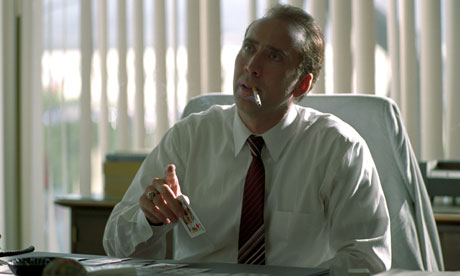
If your New Year's resolutions include a plan to give up smoking, you might want to avoid the TV and steer clear of movies for a while, too.
Scientists have found that simply watching movie stars take a drag on a cigarette is enough to spark a pattern of activity in smokers' brains that mirrors the act of lighting up.
This response to seeing smoking on screen is thought to make cravings more intense for those who are trying to quit a habit that kills 5 million people worldwide each year.
The researchers scanned the brains of smokers and non-smokers while they watched film stars puff on a cigarette. The scans showed that specific parts of the brain went into action, but only if the person was a smoker. The particular brain areas were involved in planning and coordinating movements in the person's smoking hand – as if the brain were preparing itself for the physical actions required for smoking.
Other brain circuits that dealt with urges and rewards also flickered into life when smokers saw actors light up on screen. At the end of the study, it was the smokers who had the most active reward circuits who said they craved a cigarette the most.
The work provides fresh insight into the challenge smokers face when they try to quit, but so far there is no good evidence that watching movies that contain smoking scenes actually reduces a person's chances of kicking the habit.
The finding, reported in the Journal of Neuroscience, builds on previous research that found smokers were more likely to fancy a cigarette after watching films that included smoking scenes.
"When a smoker sees someone smoking, their brain seems to simulate the movements they would make if they were having a cigarette themselves," said Todd Heatherton at the Centre for Social Brain Sciences at Dartmouth College in New Hampshire.
While former smokers might be able to avoid some social situations that could tempt them to smoke again, the ubiquity of movies and television makes it hard to escape the occasional smoking scene, the researchers said.
"In our daily lives we constantly get impulses to do things and often we don't know where they come from. If we can identify how something like a movie can affect us, then perhaps it will at least help us deal with it," Heatherton said.
He and his graduate student, Dylan Wagner, invited 17 smokers and 17 non-smokers to watch the first half hour of the 2003 Ridley Scott movie Matchstick Men while their brains were scanned by functional magnetic resonance imaging. The researchers chose the film because it features smoking prominently, but lacks scenes of sex, violence and alcohol use.
When smokers viewed the smoking scenes, there was greater activity in part of the brain called the intraparietal sulcus and other structures that play a role in perceiving and coordinating physical movements. Reward circuits in a brain region called the dorsal anterior cingulate cortex also lit up.
None of those who took part knew the study was looking at smoking.
There are 1.2 billion smokers around the world, more than 900 million of them living in developing countries. Researchers at Harvard School of Public Health estimate that there were 4.83m premature deaths in 2000 as a result of smoking, mostly from heart disease and lung cancer.
Last year, the US Centres for Disease Control and Prevention warned that smoking scenes in movies made adolescents more likely to smoke. Although smoking scenes have become less common in recent years, around half of popular movies included smoking in some form in 2009, the organisation said.

